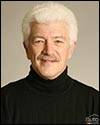Each year, in Canada, about one billion liters of lubricating oil is sold. Yet, only 250 millions are recollected. The reprocessing of oil to its original state
is called "re-refining". Used lubricating oil can be re-refined a number of times while losing only small quantities. This process takes three times less energy than the refining of crude petroleum.
Lubricating oil is a mix of hydrocarbons (long chains of carbon atoms). In these hydrocarbon chains, most of the lubricating oil molecules usually have between 25 and 40 carbon atoms. Used oil is normally formed by various types of lubricating oil that have been contaminated or chemically altered. The most common contaminants are dirt, metal particles, oxidized oil, fuels and water. Chemical changes are also possible when one or several hydrogen atoms in the hydrocarbon chain are replaced by oxygen, sulfur or other elements/molecules.
One of the methods used by companies to re-refine used oil is called vacuum distillation/filtration. First, the distillation phase eliminates residual water and trapped fuels. Then, the filtration phase eliminates impurities such as sulfur, nitrogen and chlorinated compounds.
Used oil distillation is a four-step process. The first step eliminates water, most of the solvents as well as the light fraction (fuel, for example). Residual water is processed by a used water purification system before being released into the environment, while the light organic fraction serves as fuel for the process. The purified oil is then further distilled in order to take out all the remaining hydrocarbons. This step is done inside a stripping column for vacuum distillation. During the process, oil is vacuum-heated at low temperatures to prevent the hydrocarbon chains from breaking or creating a solid residue (similar to coal). The result, which resembles oil, serves as fuel for the re-refining.
The third and fourth steps of the distillation process are identical; they both involve thin layer evaporators. These evaporators work with less vacuum and at higher temperatures, which allows lubricating oils to evaporate into gaseous matter and, at the same time, to get rid of dirt and other physical impurities. Inside the thin layer evaporators, used oil flows into a dual-channel heat exchanger where a set of blades spread the oil against the interior channel wall, which makes the evaporation easier. The resulting gases are collected and condensed into liquid oil. Meanwhile, the residual part that did not evaporate during the third and fourth steps is sold as a thinner for tar (used for roof repair and road pavement).
After the distillation process, liquid oil is chemically processed with hydrogen in a high temperature and high pressure chamber in order to replace any hydrogen atom missing from the hydrocarbon chain and to catalyze the efficient elimination of sulfur, chlorine, oxygen and other impurities.
As a result, re-refined oil is as pure as virgin oil. Various additives can be incorporated to produce engine oils, hydraulic oils and other special types of oil.
Source: Frank Wagner, 1-800-265-2792, ext. 325, Safety-Kleen, Breslau, Environmental Health and Safety Department
 |
Lubricating oil is a mix of hydrocarbons (long chains of carbon atoms). In these hydrocarbon chains, most of the lubricating oil molecules usually have between 25 and 40 carbon atoms. Used oil is normally formed by various types of lubricating oil that have been contaminated or chemically altered. The most common contaminants are dirt, metal particles, oxidized oil, fuels and water. Chemical changes are also possible when one or several hydrogen atoms in the hydrocarbon chain are replaced by oxygen, sulfur or other elements/molecules.
One of the methods used by companies to re-refine used oil is called vacuum distillation/filtration. First, the distillation phase eliminates residual water and trapped fuels. Then, the filtration phase eliminates impurities such as sulfur, nitrogen and chlorinated compounds.
Used oil distillation is a four-step process. The first step eliminates water, most of the solvents as well as the light fraction (fuel, for example). Residual water is processed by a used water purification system before being released into the environment, while the light organic fraction serves as fuel for the process. The purified oil is then further distilled in order to take out all the remaining hydrocarbons. This step is done inside a stripping column for vacuum distillation. During the process, oil is vacuum-heated at low temperatures to prevent the hydrocarbon chains from breaking or creating a solid residue (similar to coal). The result, which resembles oil, serves as fuel for the re-refining.
 |
After the distillation process, liquid oil is chemically processed with hydrogen in a high temperature and high pressure chamber in order to replace any hydrogen atom missing from the hydrocarbon chain and to catalyze the efficient elimination of sulfur, chlorine, oxygen and other impurities.
As a result, re-refined oil is as pure as virgin oil. Various additives can be incorporated to produce engine oils, hydraulic oils and other special types of oil.
Source: Frank Wagner, 1-800-265-2792, ext. 325, Safety-Kleen, Breslau, Environmental Health and Safety Department


